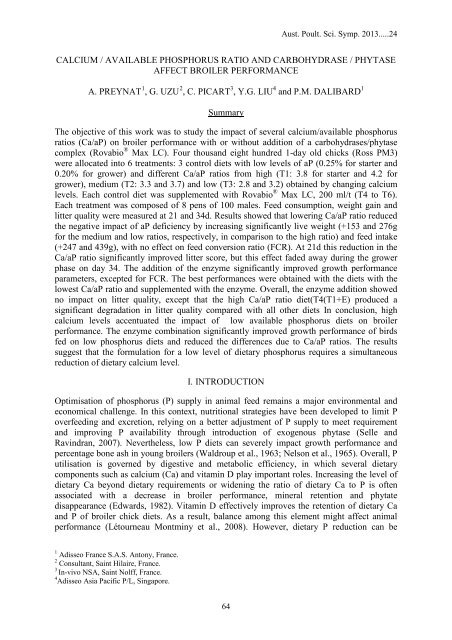APSS 2013 Proceedings - The University of Sydney
APSS 2013 Proceedings - The University of Sydney
APSS 2013 Proceedings - The University of Sydney
Create successful ePaper yourself
Turn your PDF publications into a flip-book with our unique Google optimized e-Paper software.
Aust. Poult. Sci. Symp. <strong>2013</strong>.....24<br />
CALCIUM / AVAILABLE PHOSPHORUS RATIO AND CARBOHYDRASE / PHYTASE<br />
AFFECT BROILER PERFORMANCE<br />
A. PREYNAT 1 , G. UZU 2 , C. PICART 3 , Y.G. LIU 4 and P.M. DALIBARD 1<br />
Summary<br />
<strong>The</strong> objective <strong>of</strong> this work was to study the impact <strong>of</strong> several calcium/available phosphorus<br />
ratios (Ca/aP) on broiler performance with or without addition <strong>of</strong> a carbohydrases/phytase<br />
complex (Rovabio ® Max LC). Four thousand eight hundred 1-day old chicks (Ross PM3)<br />
were allocated into 6 treatments: 3 control diets with low levels <strong>of</strong> aP (0.25% for starter and<br />
0.20% for grower) and different Ca/aP ratios from high (T1: 3.8 for starter and 4.2 for<br />
grower), medium (T2: 3.3 and 3.7) and low (T3: 2.8 and 3.2) obtained by changing calcium<br />
levels. Each control diet was supplemented with Rovabio ® Max LC, 200 ml/t (T4 to T6).<br />
Each treatment was composed <strong>of</strong> 8 pens <strong>of</strong> 100 males. Feed consumption, weight gain and<br />
litter quality were measured at 21 and 34d. Results showed that lowering Ca/aP ratio reduced<br />
the negative impact <strong>of</strong> aP deficiency by increasing significantly live weight (+153 and 276g<br />
for the medium and low ratios, respectively, in comparison to the high ratio) and feed intake<br />
(+247 and 439g), with no effect on feed conversion ratio (FCR). At 21d this reduction in the<br />
Ca/aP ratio significantly improved litter score, but this effect faded away during the grower<br />
phase on day 34. <strong>The</strong> addition <strong>of</strong> the enzyme significantly improved growth performance<br />
parameters, excepted for FCR. <strong>The</strong> best performances were obtained with the diets with the<br />
lowest Ca/aP ratio and supplemented with the enzyme. Overall, the enzyme addition showed<br />
no impact on litter quality, except that the high Ca/aP ratio diet(T4(T1+E) produced a<br />
significant degradation in litter quality compared with all other diets In conclusion, high<br />
calcium levels accentuated the impact <strong>of</strong> low available phosphorus diets on broiler<br />
performance. <strong>The</strong> enzyme combination significantly improved growth performance <strong>of</strong> birds<br />
fed on low phosphorus diets and reduced the differences due to Ca/aP ratios. <strong>The</strong> results<br />
suggest that the formulation for a low level <strong>of</strong> dietary phosphorus requires a simultaneous<br />
reduction <strong>of</strong> dietary calcium level.<br />
I. INTRODUCTION<br />
Optimisation <strong>of</strong> phosphorus (P) supply in animal feed remains a major environmental and<br />
economical challenge. In this context, nutritional strategies have been developed to limit P<br />
overfeeding and excretion, relying on a better adjustment <strong>of</strong> P supply to meet requirement<br />
and improving P availability through introduction <strong>of</strong> exogenous phytase (Selle and<br />
Ravindran, 2007). Nevertheless, low P diets can severely impact growth performance and<br />
percentage bone ash in young broilers (Waldroup et al., 1963; Nelson et al., 1965). Overall, P<br />
utilisation is governed by digestive and metabolic efficiency, in which several dietary<br />
components such as calcium (Ca) and vitamin D play important roles. Increasing the level <strong>of</strong><br />
dietary Ca beyond dietary requirements or widening the ratio <strong>of</strong> dietary Ca to P is <strong>of</strong>ten<br />
associated with a decrease in broiler performance, mineral retention and phytate<br />
disappearance (Edwards, 1982). Vitamin D effectively improves the retention <strong>of</strong> dietary Ca<br />
and P <strong>of</strong> broiler chick diets. As a result, balance among this element might affect animal<br />
performance (Létourneau Montminy et al., 2008). However, dietary P reduction can be<br />
1 Adisseo France S.A.S. Antony, France.<br />
2 Consultant, Saint Hilaire, France.<br />
3<br />
In-vivo NSA, Saint Nolff, France.<br />
4 Adisseo Asia Pacific P/L, Singapore.<br />
64
















